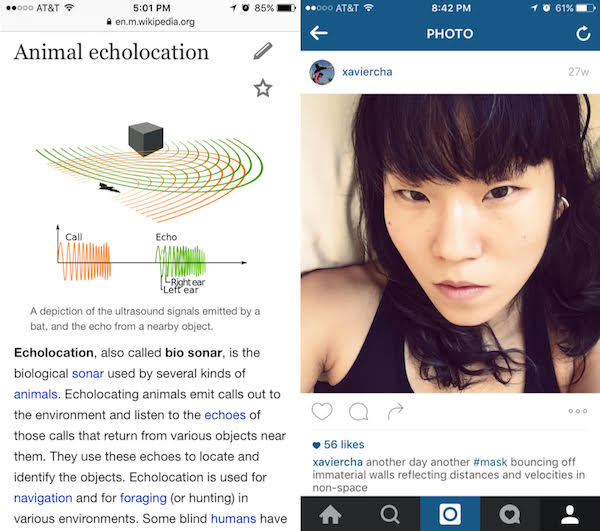Simulating Feeling: Xavier Cha On Feedback
Xavier Cha’s latest performance, titled Feedback, at 47 Canal is a clear departure from tropes of the ever-downwardly trending net-art stratagems.
Following several exhibitions dealing more directly with sousveillance, mediation, and the body, Cha’s latest performance for the Chinatown gallery is notably unmediated. The casual observer steps seamlessly from the street into the performance: a group of students sitting on bleachers rigorously acts out a succession of reactive emotions characteristic of a syndicated American talk show audience. The reenactment of audience lacks a visible referent or technical apparatus. The only visual anchor for the piece is its performers. Nevertheless, the piece reveals the affective intrusion of social media currently hijacking our emotional lives; it zooms in on the virtual bodies which “lmao” and “smdh” the way physical bodies can only simulate.

“It definitely relates to the way we become alienated from the physical expression of our emotions after becoming used to the seamlessness of our digital lives,” Cha says, elaborating on the project.
“Feedback is another representation of this state,” she says, which she calls an “awkward state of crisis.” Cha has previously investigated ontological emptiness at 47 Canal in Untitled (2012), where participants on DMT and Salvia were filmed in dehumanizing states. For Feedback, Cha uses animal echolocation as a metaphor to understand our developing relationships with new modes of interaction. “I relate this to posting selfies or whatever on Instagram” she explains. “You check on your relevance and place. You identify yourself in relation to your surroundings based on how quickly things bounce back, how many likes you get, who these likes are from, etc.”

Appropriately, I first came across the work via hyperlink—specifically, an ARTnews post titled “Why Not Apply To Be In A Xavier Cha Performance in New York?” Googling to verify, I found the referenced casting ad. The ad clipping refers to an open call for basically any person living in downtown Manhattan or Brooklyn, lending the performance a pedestrian quality.
At the rehearsal the following week, it was clear that Feedback would be a live continuation of Abduct, a Frieze Film commission that premiered in October. Participants, mostly MFA types, were given a printout of an Excel table with timed sketches to be acted out. These micro-performances ranged from blank staring to deadpan applause to hysterical disapproval. Feedback is an intense and confrontational exposition. Gallery staff could occasionally be spotted wearing earplugs for protection. At the rehearsal, the performers collectively acknowledged how conveying so many feelings was more draining than expected. Without a significant material component, the focus shifts to the emotional labor of the actors.

Even strict theatrics cannot escape the scrutiny of the “post-internet” Anthropocene. The syndicated casting ads online are proof of a kind of art that’s inherently sourced from invisibly networked participants. In a 2008 interview with Rhizome, Guthrie Lonergan presciently commented on the future of net art, saying, “Right now I’m scheming how to take the emphasis off of the Internet and technology, but keep my ideas intact. Objects that aren’t objects…” Cha’s choreography executes a vision of the body that is undoubtedly “internet aware.
“The effort is inextricably linked to its central conceit: the endless affective work of Instagram,” Cha says. When I asked her about this unifying concept, she responded over email, saying, “I was thinking about how so much of our behavior and interaction with reality is premeditated and determined by the feedback, the likes and comments, re-posts, etc.” The eternal return of validation constitutes the circulatory system of an information-driven social body. The collapse of Instagram model Essena O’Neill, and the viral mediocrity of Amalia Ulman’s Excellences & Perfections, are driven by remote forces of collective validation, disapproval, and boredom. These are emotions that Feedback reifies, like a “lol” that is actually “laughing out loud” or the often comatose state of passive attentiveness that outwardly registers as nothing more than blankness. Our fear/hope of becoming the machine is being actualized as the body becomes a vehicle abducted by Cha in the service of script. Human feeling is savage technology where culture acts as software. Culture as a technical code is embedded in us. In much of Cha’s work, the dramatized body is deployed as a media player translating hidden directives. When I asked her how much of the work came from a personal experience, she explained, “It is definitely not based on personal narrative—rather the opposite. I intentionally didn’t want to allow viewers to be able to attach to any character, narrative, emotional arc, empathy, or desire.” Cha’s absence as a performer highlights further the simultaneously detached and depersonalized way we have come to invest ourselves emotionally in social networks.

The ability to participate in elaborate systems of validation gives us a sense of autonomy that is ultimately illusory and unstable. The virtual self is in actuality disembedded from content, something which Cha calls “secondary, and almost arbitrary,” functioning as a site for asymmetric interaction. Feedback is essentially void of direct content. The intense expression of its performers creates an illusion that something interesting is happening on the gallery walls when in fact the space is barren. As a temporary installation, the work attempts to resist traditional modes of commodification in a cultural moment when mere spectatorship can be extracted as market value in the form of personal data.
freda nada is a writer and new media theorist. Her work has appeared via new inc, bullet magazine, new bloom and the huffington post. she is currently working with live programming at ps1 and focusing on web/electronic based projects. her social networks identifier is @spxghett1.